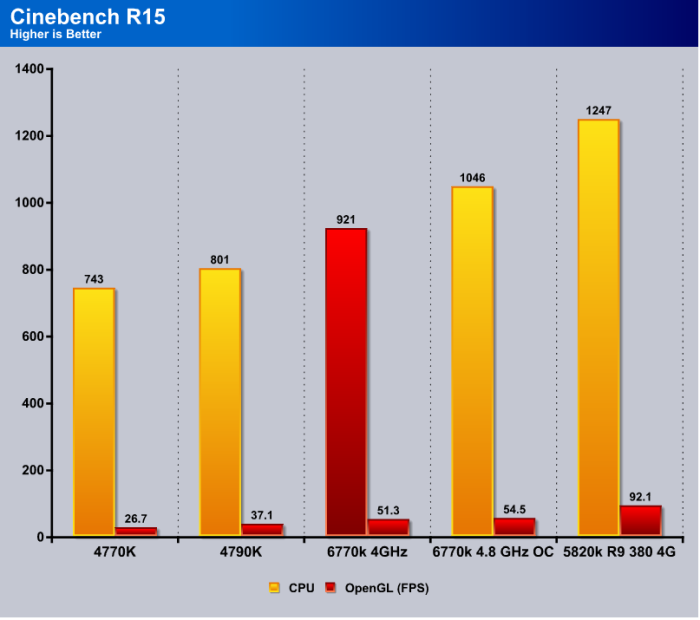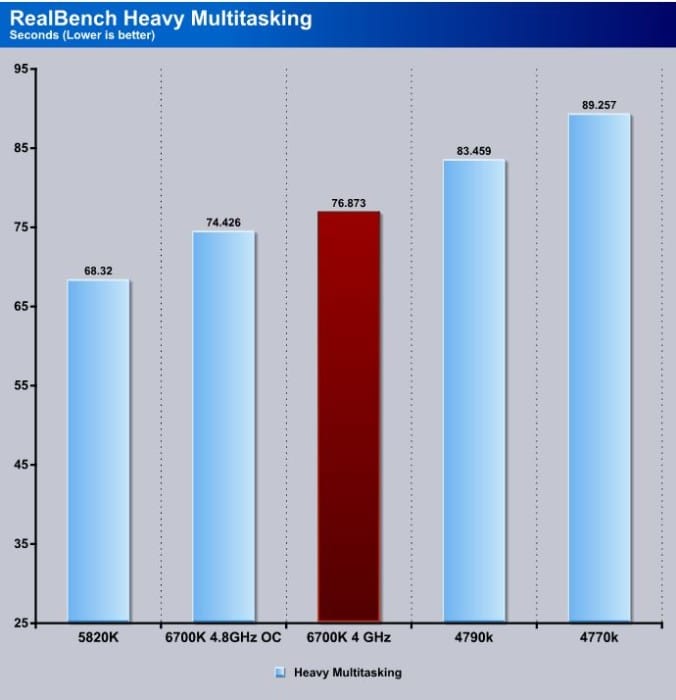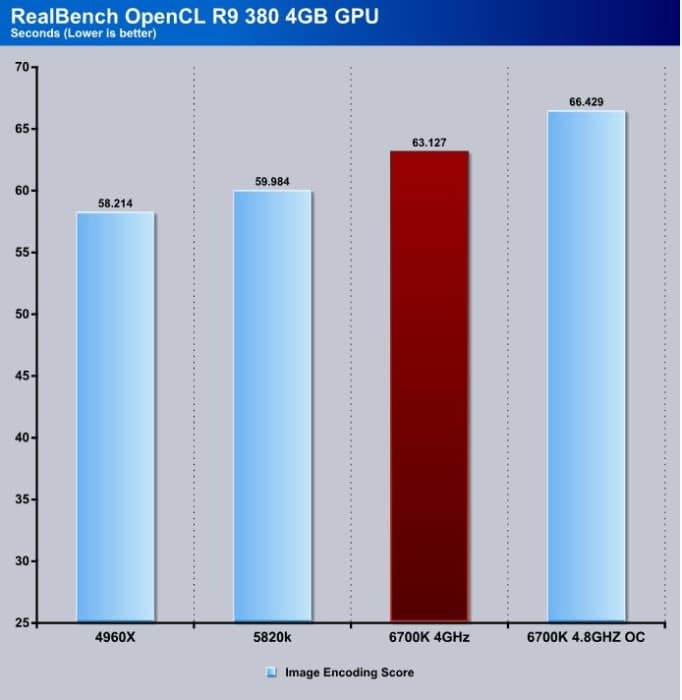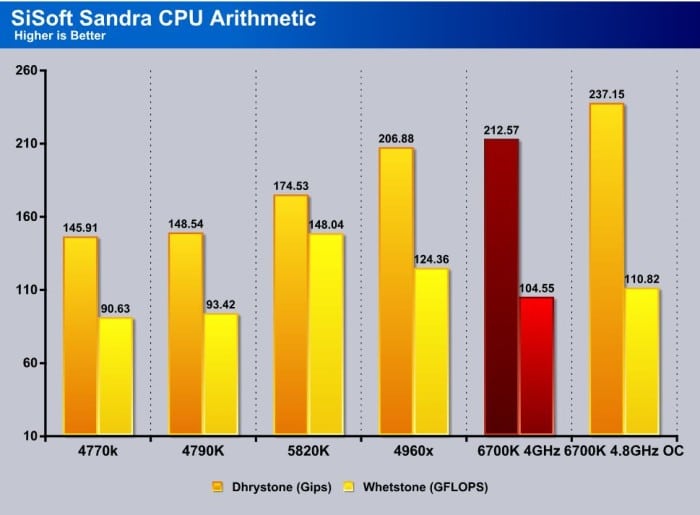Test Rig & Benchmarks
We went pretty standard with our tests, we turned off the Virus Scanner and the MalWare program, removed excess drives on the machine and just left the Crucial MX100 SSD so no indexing would take place, We emptied Prefetch and the cache between tests. When we did a cold startup of the machines we allowed 10 minutes for Windows housekeeping to finish and give us all the processor cycles it could. We didn’t close a lot of host services or strip down the OS turning things off to get better numbers, We left it at turning off the scanners, clearing the caches and prefetch and ran the tests just like you would on your machine at home. All of the Asus Utilities were installed but no excess programs. Just Windows 10 Pro fully updated, the Asus Drivers Disk and the Utilities that came with the Hero VIII.
We ran each Test 3 times and average those three runs to give you the scores we report here.
| Test Rig “Quadzilla” |
|
| Case Type | |
| CPU | Intel Core I7 6700K 4.0 – 4.2GHz |
| Motherboard | |
| Ram | |
| CPU Cooler | EKWB L360 (EK-Kit L360) |
| Hard Drives | |
| Optical | Liteon DVD Burner |
| GPU | Asus Strix R9 390X Gaming 8G OC |
| Case Fans | 1 x 180mm Mosfet / CPU / Ram cooling fan 1 x 120mm PCI-E Cooling Fan |
| Docking Stations | None |
| Testing PSU | |
| Legacy | None |
| Mouse | |
| Keyboard | |
| Any Attempt Copy This System Configuration May Lead to Bankruptcy | |
Benchmarks
PCMark 7
The natural 4.2GHz turbo speed of the i7 6700k was enough to put it at the top of PCMark 7’s Computation test. Running at stock speed the 6700K scored a 20757 and (Spoiler Alert) running at 4.8GHz we hit 24511 which is a nice boost.
We used the same model SSD for all of our storage testing the Crucial MX100 240GB SSD, a while back NewEgg had them on closeout and since they run at 550MB/s read we purchased 5 of the MX 100 drives so all the test beds could use the same exact drive with a minimum of hassles. From the 4770K to the 6700K we got very little differentiation in speeds so we are calling the storage test a tie.
Entertainment tests tend to be multi-core oriented and the 4790K and the 6770K just about tied at the 6700K’s overclock speed of 4.8GHz. Perhaps the 4790K’s turbo of 4.4GHz was enough to tie the two processors. We ran most of the tests with the HD530 Integrated Graphics processor on the 6700K but we also tossed a R9 380 4G into the mix. When we strapped the R9 380 4G onto the 6700K we topped the chart and scored a 7280 in Entertainment.
The 4790K snuck past the 6700K by just a hair but apply the OC the 6700K and it tops the charts using the IGP. When we slapped the R9 390 4G on the 6700K things got even better and it scored a 7605.
Super PI Mod 1.9
Super PI is a single-threaded benchmark that calculates Pi to a specific number of digits. It uses the Gauss-Legendre algorithm and is a Windows port of a program used by Yasumasa Kanada in 1995 to compute Pi to 232 digits.
In SuperPi the 6700K and 4790K ran so close together we could call it a tie but the 4790K has the advantage of faster ram, the 6700K is running 2400MHz HyperX and the 4790K is running 2666MHz HyperX giving it a little advantage. When we OC the 6700K to 4.8Ghz it takes the lead in SuperPi turning in a score of 80.373 in the 8M test and 7.675 in the 1M test. Skylake is looking pretty good at this point.
wPrime
wPrime is a leading multithreaded benchmark for x86 processors that tests your processor performance by calculating square roots with a recursive call of Newton’s method for estimating functions, with f(x)=x2-k, where k is the number we’re sqrting, until Sgn(f(x)/f'(x)) does not equal that of the previous iteration, starting with an estimation of k/2. It then uses an iterative calling of the estimation method a set amount of times to increase the accuracy of the results. It then confirms that n(k)2=k to ensure the calculation was correct. It repeats this for all numbers from 1 to the requested maximum.
The 4960x peaked out ahead of the 6700K by just a hair and again we would attribute that to faster Ram and having 2 more cores. Considering that the 4960k has 6 cores and the Skylake 6700K has 4 you can pretty much call that a win for Skylake based on a core vs core comparison. You disable 2 cores on the 4960K and it would be well behind the 6700K.
3DMark
3DMark includes everything you need to benchmark your hardware in one app. Whether you’re gaming on a smart phone, tablet, notebook, laptop, desktop, or a high performance gaming PC, 3DMark includes a benchmark designed specifically for your type of device. And it’s not just for Windows. You can compare your scores with Android and iOS devices too. It’s the best 3DMark we’ve ever created.
Just to let you know we were working on a new processor, with a new Motherboard with a new OS and under those condition there will be some minor bugs. In our case we had higher resolution Korean made monitors having trouble with the HD530 graphics. HD530 being the new IGP inside the 6700K we had to test it but the only resolution it would let us test in at the time was 1680 x 1050 which id ok because the HD530 is good for light Facebook gaming and HD playback but it’s not a gaming monster and would seriously struggle with most games at 1080p. As soon as the kinks are worked out we will try to revisit 3DMark and update the results.
First we ran the 6700K stock speed and got a 9532 in CloudGate, we lit up the OC and hit 9953. We didn’t see the need to fire up a bunch of processors for this test being limited to 1680 x 1050 so we fired up our 5820K with an R9 380 4G and it hit 37420 on Cloudgate but the 6700K beat it by a few points and it hit 37760 a pretty impressive score for a quad.
Hitting 3DMark FireStrike at 1680 x 1050 you can tell the HD 530 isn’t going to be a gangbuster power house IGP but the fact remains the vast majority of motherboards bought with an IGP never see a GPU and they are used for light computing so IGP’s have their uses and as the generational flow continues we may see IGP’s playing a larger role.
The i7 6700k hit 997 in FireStrike and an 1137 when overclocked to 4.8GHz. We slipper the old R9 380 onto the 6700K and the 5920k and once again the higher native speed of the i7 6700K bested the 5920K at stock speed. We suspect you fire the 5920K up to its normal 4.4GHz speed it would give the 6700K some trouble but we are mainly looking at stock speeds with the GPU on both platforms.
The Last Test in 3DMark was SkyDiver and the 6700K hit 4421 stock speed and OC’d it hit 4791 which isn’t shabby for an IGP by any means. The i7 6700 with the R9 380 4G hit 28454 and the 5920K was hard pressed to squeak by ut with a slightly higher score but nothing definitive enough to declare a win.
CINEBENCH R15
CINEBENCH is a real-world cross-platform test suite that evaluates your computer’s performance capabilities. CINEBENCH is based on MAXON’s award-winning animation software CINEMA 4D, which is used extensively by studios and production houses worldwide for 3D content creation. MAXON software has been used in blockbuster movies such as Iron Man 3, Oblivion, Life of Pi or Prometheus and many more.

We ran CineBench and the 6700K beat out all the processors except the Hexacore 5920K which beat out the 6700K by a couple of hundred points when equipped with the R9 380.
x264 HD
Simply put, x264 HD Benchmark is a reproducible measure of fast your machine can encode a short HD quality video clip into a high quality x264 video file. It’s nice because everyone running it will use the same video clip and software.
X264HD see’s the 6700K at 20.17 two pass when OC’d and 80.34. OC the 6700K and it hits 89.46 two pass and single pass it hits 22.23 and for some odd reason the 4960X squeaked past it by a few FPS perhaps the extra cores on the Hex carried it ahead of the 6700K Quad.
Unigine Heaven 4.0
Heaven Benchmark, with its current version 4.0, is a GPU-intensive benchmark that hammers graphics cards to the limits. This powerful tool can be effectively used to determine the stability of a GPU under extremely stressful conditions, as well as check the cooling system’s potential under maximum heat output. It provides completely unbiased results and generates true in-game rendering workloads across all platforms
The Intel I7 6700K did well in Unigine Heaven 4.0 edging out the 5820k by a couple of FPS. The problem with motherboards and GPU’s these days is stick any modern GPU into any modern motherboard and the scores will be close together. In order to see any real graphical differences you would need to go to a CPU and board that bottlenecks the video card, we just don’t see that very often unless using a couple of GTX 980Ti in SLI or a couple of Titans.
Handbrake
We used a 900K Big Buck Bunny video and trans-coded it from AVI to MP4 three times, we added up those 3 runs and averaged the scores reported here.
Here is a detailed breakdown of HandBrake’s features:
Built-in Device Presets—Get started with HandBrake in seconds by choosing a profile optimized for your device, or choose a universal profile for standard or high quality conversions. Simple, easy, fast. For those that want more choice, tweak many basic and advanced options to improve your encodes.
- Supported Input Sources—Handbrake can process most common multimedia files and any DVD or Blu-ray sources that do not contain any kind of copy protection.

Even the mighty 5820k running at stock speed couldn’t overcome the 6700K’s speed advantage and the i7 6700K scored an 83.4 second score but when we OC’d it to 4.8Ghz it scored a 76.2.
ROG RealBench
RealBench uses real, open source applications to test your PC as it would perform in RL. Although it can be competitive, it’s not primarily designed to be more hardcore and time-consuming – it’s a benchmark for everyone.
Select the three tests and run the benchmark to get your result. Each test uses different parts of your PC subsystem, so all areas are covered. Share the result here on the forum to compare to others, or, compare to pre/post overclocks and pre/post upgrades to get maximum value from your PC.

We’ve had our eye on RealBench and it’s proven to scale well with most components so we gave it a shot at the CPU collection. In heavy multitasking it scored a 76.873 stock speed and OCed it hit 74.426 and was only bested by the Haswell-E 5820K which is a Hex core so it has a little advantage.
Image editing the i7 6700K scored a 95.631 and beat the other processors easily and it only got better when we overclocked it.
OpenCL the Hex cores took the advantage and ran with it and the 6700K scored a 63.127 and for a Quad Core that is an excellent score.
RealBench Image Encoding is another of those more cores is better benchmarks but Quad, Hex and even Oct cores are a fact of life. The i7 6700K came in behind the Hex cores which is to be expected. The i7 6700K scores a 101.095 beating the 4770K and when overclocked scores a 95.831.
SiSoft Sandra

In the Memory Bandwidth test the i7 6700K got 30.14 GB/s at stock speed and 31.28 GB/s when overclocked beating the i7 5820K by a slim margin.
In the CPU arithmetic test the Intel i7 6700K scores a 212.57 Dhrystone and 104.55 Whetstone it was already at the front of the pack but it got even better when we OC’d it and it scores a 237.15D and 110.82W.
TrueCrypt
TrueCrypt is a discontinued source-available freeware utility used for on-the-fly encryption (OTFE). It can create a virtual encrypted disk within a file or encrypt a partition or (under Microsoft Windows except Windows 8 with GPT) the entire storage device (pre-boot authentication).

At Stock speed the 4960X bested the 6700K but it’s those pesky hex cores again, In TrueCrypt at stock speed the i7 6700K hit 5.6GB/s and overclocked took top honors in a tie with the 4960K both scoring 5.9GB/s
Battlefield 4
Battlefield 4™ on PC, powered by the advanced technology of DICE’s proprietary Frostbite™ 3 engine, blurs the line between game and glory. With dynamic destructable environments, vehicular combat, and the chaos of all-out-war with 64 players, Battlefield 4 on PC is an unmatched interactive experience.
In addition to its hallmark multiplayer, Battlefield 4 features an intense, dramatic character-driven campaign that starts with the evacuation of American VIPs from Shanghai and follows your squad’s struggle to find its way home.
There is no comparison. Immerse yourself in the glorious chaos of all-out war, found only in Battlefield.
Battlefield 4 and the R9 380 4G shot that the Intel Core I7 6700K is more than capable of gaming, The 6700K beat out the 5820K using the same GPU but at stock speed only by a couple of FPS, When we whipped the OC on the i7 6700K it jumped out 5 frames in front of the 5820k, Games tend to like faster processors over processors with more cores.
Bioshock Infinite
Set in 1912, the game has protagonist, former Pinkerton agent Booker DeWitt, sent to the floating air city of Columbia to find a young woman, Elizabeth, who has been held captive there for most of her life. Though Booker rescues Elizabeth, the two become involved with the city’s warring factions: the nativist and elite Founders that rule Columbia and strive to keep its privileges for White Americans, and the Vox Populi, underground rebels representing the underclass of the city. During this conflict, Booker learns that Elizabeth possesses strange powers to manipulate “Tears” in the space-time continuum that ravage Columbia, and soon discovers her to be central to the city’s dark secrets.
We tested BioShock Infinite with the 5820k and the Core I7 670K using the XFX R9 380 4G because we wanted to present results that are obtainable on most budgets. It’s easy to forget that not everyone has $25,000 worth of computer equipment filling an entire room. Most people are lucky to have a R9 380 4G class or equivalent GPU. We wanted to go with an affordable GPU and the $200 – $250 R9 380 G4 was the least expensive one we had handy.
Here again in BioShock Infinite the Intel i7 6700K flexes its gaming muscle and tops the hex core i7 5820k, were sure it’s the speed advantage the 6700K has and it hit 91.34 FPS stock clocked and when OC’d it hit 94.22.
 Bjorn3D.com Bjorn3d.com – Satisfying Your Daily Tech Cravings Since 1996
Bjorn3D.com Bjorn3d.com – Satisfying Your Daily Tech Cravings Since 1996






































Good review! I want one! Time to change my good old Rampage III Formula, 12 gig and i7 950 4Ghz.
(But not my SLI GTX980) 😛